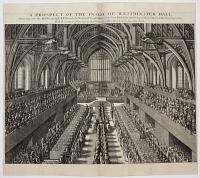
A Prospect of the Inside of Westminster Hall, Shewing how the King and Queen, with the Nobility and Others, did Sit at Dinner on the day of the Coronation, 23 April 1685 [...]
S Moore fecit [1687]
Engraving, sheet 390 x 505mm (15¼ x 19¾"). False margins top and bottom.
Banquet at Westminster Hall, held as part of the coronation of James II and Mary of Modena on 23 April 1685. Illustration to Francis Sandford, 'The history of the coronation of the Most High, Most Mighty, and Most Excellent Monarch, James II, by the grace of God, King of England, Scotland, France, and Ireland, defender of the faith, &c. And of his royal consort, Queen Mary' (London, 1687). Sandford worked for two years with his fellow herald Gregory King to produce this record of the coronation rituals, which included twenty-seven lavish engravings of the sumptuous feasts, processions and fireworks in a style previously unseen in the British Isles. Unfortunately for Sandford, the book appeared shortly before the Glorious Revolution which saw James II flee the country, and the authors barely cleared their expenses.
[Ref: 42915] £380.00
![[Plan of Westminster Abbey as arranged for coronation of James II]](img-thumbnail/jpegs/42918.jpg)
[Plan of Westminster Abbey as arranged for coronation of James II] The Ground Plot of The Collegiate Church of St Peter in Westminster With two Profiles relating thereunto [...]
[1687]
Engraving, sheet 375 x 510mm (14¾ x 19¾"). Trimmed lower edge with false margin added; torn along central fold
Illustration to Francis Sandford, 'The history of the coronation of the Most High, Most Mighty, and Most Excellent Monarch, James II, by the grace of God, King of England, Scotland, France, and Ireland, defender of the faith, &c. And of his royal consort, Queen Mary' (London, 1687). Sandford worked for two years with his fellow herald Gregory King to produce this record of the coronation rituals, which included twenty-seven lavish engravings of the sumptuous feasts, processions and fireworks in a style previously unseen in the British Isles. Unfortunately for Sandford, the book appeared shortly before the Glorious Revolution which saw James II flee the country, and the authors barely cleared their expenses.
[Ref: 42918] £90.00
(£108.00 incl.VAT)
![[James II in his palace with parliament entering; revoking his decision to form a parliament; arriving in Ambleteuse by boat; and arriving in St Germain-en-Laye]](img-thumbnail/jpegs/42559.jpg)
[James II in his palace with parliament entering; revoking his decision to form a parliament; arriving in Ambleteuse by boat; and arriving in St Germain-en-Laye] de k: gaet over bloulange na Parys en: St germain [...]
[Anon., c.1688]
Two etchings, both approx 165 x 110mm (6½ x 4¼"). Trimmed. Both tipped into same backing sheet.
Scenes depicting James II's departure from England in 1688. After William of Orange landed in England in November 1688, James decided to flee. Leaving London, he got as far as Faversham in Kent before his boat was intercepted and he needed a company of guards to rescue him. James then briefly attempted resume government before receiving a request from William to remove himself. This he did, travelling to Rochester in Kent and from there on to France. He landed in Ambleteuse, near Boulogne, on Christmas day, and from there travelled to the chateau of St Germain-en-Laye which Louis XIV had given him. These etchings are all copied from prints in a set of twenty-five by Adriaan Schoonebeek depicting events in the struggle for the British crown from the civil war to the coronation of William III and Mary II.
[Ref: 42559] £260.00
(£312.00 incl.VAT)
![[James II intercepted at Faversham; embarking at Rochester; arriving in Ambleteuse; and riding from Boulogne to Paris]](img-thumbnail/jpegs/42565.jpg)
[James II intercepted at Faversham; embarking at Rochester; arriving in Ambleteuse; and riding from Boulogne to Paris] Kon. Jacob word tot Feversham opgeworpen: aldaar mishandeld, en verzeekerd [...]
[Anon., c.1688]
Etching, rare, sheet 255 x 295mm (10 x 11½"). Tipped into backing sheet.
Scenes depicting James II's departure from England in 1688. After William of Orange landed in England in November 1688, James decided to flee. Leaving London, he got as far as Faversham in Kent before his boat was intercepted and he needed a company of guards to rescue him. James then briefly attempted resume government before receiving a request from William to remove himself. This he did, travelling to Rochester in Kent and from there on to France. He landed in Ambleteuse, near Boulogne, on Christmas day, and from there travelled to the chateau of St Germain-en-Laye which Louis XIV had given him. These etchings are all copied from prints in a set of twenty-five by Adriaan Schoonebeek depicting events in the struggle for the British crown from the civil war to the coronation of William III and Mary II.
[Ref: 42565] £280.00
(£336.00 incl.VAT)
![[James II] The Flight of the Popedom out of England.](img-thumbnail/jpegs/42697.jpg)
[James II] The Flight of the Popedom out of England.
[Romain de Hooghe?]
[n.d., c.1689.]
Engraving, with letterpress key glued to verso. Dutch broadside with English text. Plate: 380 x 320mm (15 x 12½"). Trimmed to image, central vertical fold, laid on album sheet.
A Dutch satirical print showing deposed James II and Louis XIV fleeing, Louis XIV riding a bear and with a peg leg leads the procession, followed by Father Petre into who's ear the Devil bellows evil, James II, his son and wife follow in a chariot. A letterpress key and lines explaining the print is glued to the verso. BM Satire 1208. See "The print in Stuart England" No 210.
[Ref: 42697] £950.00
view all images for this item
![[James II lands at Kinsale in Ireland]](img-thumbnail/jpegs/42591.jpg)
[James II lands at Kinsale in Ireland] Koning Jakobus II lant to Kingsal in Yrlant [parallel text in French]
Ad. Schoonebeek excudit [1691]
Etching, sheet 145 x 190mm (5¾ x 7½"). Trimmed and glued to backing sheet.
After William of Orange landed at Torbay in November 1688, James II left London at the second time of asking (the first time his boat was intercepted at Faversham and a body of guards had to come and return him to London) and fled to France. Louis XIV had lavishly refurbished the chateau of St Germain-en-Laye, near Paris, for James and his family. It was the perfect environment for James and his exiled court, and if he had his own way he probably never would have left. Louis XIV, however, wanted James to travel to Ireland, and from there attempt to recover his crown from the insurgent William. This scene shows James landing at Kinsale in Ireland on 12 March 1689. William III (as he was crowned in April 1689) landed in Ireland in mid-June, and defeated James at the battle of the Boyne on 1 July 1689. This precipitated James' final exile in France. Etching from a set of scenes from the Glorious Revolution and related events published by Adriaan Schoonebeek (1661-1705), Dutch printmaker who studied under Romeyn de Hooghe and later moved to Moscow to set up a printmaking workshop for Peter the Great.
[Ref: 42591] £230.00
(£276.00 incl.VAT)
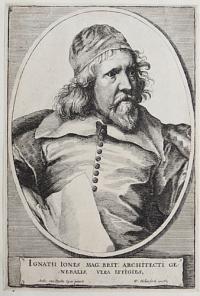
Ignatii Iones Mag: Brit: Architecti Ge://Neralis, Vera Effigies.
Anth: Van Dycke Eques pinxit. W: Hollarfecit, aqua forti.
[n.d., c.1655.]
Etching. Sheet: 205 x 135mm (8¼ x 5¼"). Trimmed and laid on album sheet.
A half-length portrait of architect Inigo Jones (1573-1652) the first English architect to employ the Vitruvian principles in his buildings; one of his most famous buildings is Banqueting House in Whitehall which was completed in 1622, 27 years before Charles I was beheaded on a scaffold before it. An illustration from 'The most notable Antiquity of Great Britain vulgarly called Stone-heng', 1655 a report commissioned by James I on the origin and nature of Stonehenge. Pennington: 1428, I of II.
[Ref: 43128] £480.00
Unfortunately this item is either sold or reserved. If you are interested in similar items and cannot find what you're looking for on our website, please consider filling in our interests form. If you register, we can also send you items that match your interests when the website is updated.

Infleix Kara Mustapha Bassa, Magni Turcarum Imperatoris Minister Primarius; Post acceptam cladem ante Viennam ab Eodem obsessam [...]
J. Gole Sc.
Ex Formis Ludovici Renard cum Privil: Ordin: Gen: Belgii Foederati [c.1690]
Engraving, 17th century watermark; sheet 365 x 260mm (14¼ x 10¼"). Trimmed; false margins top and bottom.
Merzifonlu Kara Mustafa Pasha (c.1634-1683), Ottoman military leader and grand vizier to Mehmed IV (1642-93). He led the Ottoman army in a war against Poland (which gained the region of Podolia for the Ottoman Empire) and in the famous Battle of Vienna in 1683, in which the Polish army of John III Sobieski defeated the Ottoman army. This defeat cost Mustafa his position, and ultimately his life: soon after he was executed in Belgrade, by strangulation with a silk cord.
[Ref: 42997] £230.00
(£276.00 incl.VAT)
Unfortunately this item is either sold or reserved. If you are interested in similar items and cannot find what you're looking for on our website, please consider filling in our interests form. If you register, we can also send you items that match your interests when the website is updated.
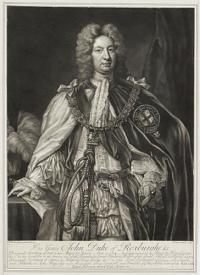
His Grace John Duke of Roxburghe &c. Principall Secretary of State to her Majesty Queen Anne in 1704...
J. Richardson pinx.t 1723. J. Faber fecit 1741.
Mezzotint. Sheet: 350 x 250mm (13¾ x 9¾"). Trimmed.
A full length portrait of John Ker, 1st Duke of Roxburgh (1680-1741), who served as Secretary of State for Scotland and helped bring about the union with England.
[Ref: 43048] £180.00
(£216.00 incl.VAT)
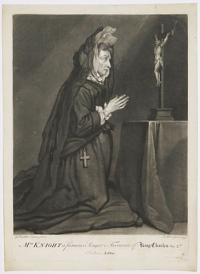
M.rs Knight a famous Singer & Favourite of King Charles the 2d. L'Collectione J. Ellys. Price 2 Shill.
G. Kneller Eques, pinx. J. Faber fecit, 1749.
1749.
Mezzotint. 350 x 250mm (13¾ x 9¾") with wide margins.
A portrait of singer Mary Knight, a well known singer and mistress of Charles II, shown kneeling before a crucifix. CS 210
[Ref: 43073] £280.00
(£336.00 incl.VAT)
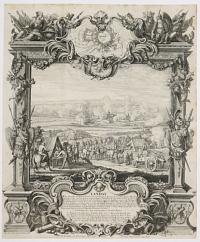
Landau.
Georg Phil. Rugendas. Abraham Drentwett Ornam: del. Ioh: August Corvinus Sculpsit.
Cum Gratia et Privileg: Sac: Caes: Majest: Ieremias Woldd excudit, Aug: Vind: [n.d., c.1720.]
Engraving. Sheet: 420 x 380mm (16½ x 15"). Trimmed, vertical crease. Slightly visible from front.
A battle scene showing the Siege of Landau in 1702, during the War of Spanish Succession in which an army of the Holy Roman Empire laid siege to the town of Landau which was held by the French. The scene is decorated with a ornate border, with a plan of the battle above. A plate from 'Repraesentatio belli ob successionem in Regno Hispanico...' published by Wolff.
[Ref: 42970] £280.00
(£336.00 incl.VAT)
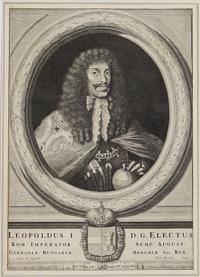
Leopoldus I. D.G. Electus Rom: Imperator Semp: August: Germaniae, Hungariae, Bohemiae Etc Rex.
Phil: Bauttats Sculp.
Ex Formis N. Visscher
Engraving, 17th century watermark; sheet 350 x 245mm (13¾ x 9¾"). Trimmed; tipped into album sheet.
Leopold I, Holy Roman Emperor (1640-1705). Leopold's reign coincided with conflicts with the Ottoman Empire in the Great Turkish War (including the famous Battle of Vienna in 1683), and three years against France. These included the War of the Spanish Succession, which resulted from Leopold's attempt to give his son Charles the entire Spanish inheritance, thus disregarding the will of Charles II of Spain. Engraved by Filibert Bouttats the Elder (1654-88), Dutch engraver working in Amsterdam, Antwerp and the Hague.
[Ref: 43011] £190.00
(£228.00 incl.VAT)
![[The Seminary of Lingen]](img-thumbnail/jpegs/42797.jpg)
[The Seminary of Lingen] Auspicus, ut Breda tuis, caput extu lit, Hellas et Latium, Lingam, sic ediere, tuam [...]
D.D.D. Romanus de Hooghe J.U.S. et Commissarius Regius Ling. [c.1690]
Etching, sheet 445 x 580mm (17½ x 22¾"). Two folds; hardly visible from front. Top part central repaired.
The seminary at Lingen in Lower Saxony, Germany, etched by Romeyn de Hooghe (1645-1708), Dutch Baroque printmaker best known for his political caricatures of Louis XIV and his prints glorifying William III and the Glorious Revolution. In 1689 William III appointed de Hooghe commissioner in charge of the exploration of stone quarries in Lingen in order to obtain building materials for the royal hunting lodge of Het Loo. This print praises the appetite for learning amongst the town's inhabitants. Landwehr p.338.
[Ref: 42797] £520.00
![[Battle of Lowestoft.] Battaglia Navale tra'Inglesi, et Olandesi Successa adi 13 di Gingno 1665.](img-thumbnail/jpegs/42718.jpg)
[Battle of Lowestoft.] Battaglia Navale tra'Inglesi, et Olandesi Successa adi 13 di Gingno 1665.
[n.d., c.1674.]
Engraving. Plate: 370 x 300mm (14½ x 12"), with very large margins. Vertical and horizontal folds, damage to edge and plate on lower left edge. Crease.
A battle scene showing the Battle of Lowestoft fought between the English and the Dutch during the Second Anglo-Dutch War on the 13th June 1665. From Galeazzo Gualdo Priorato's ''Teatro del Belgio o sia descritione delle diecisette Provincie del medesimo''.
[Ref: 42718] £280.00
(£336.00 incl.VAT)

The North-West Prospect of Maidstone, in the County of Kent.
Sam.l and Nath.l Buck delin. et Sculp.t.
According to Act of Parliament 1738.
Engraving. Plate: 310 x 790mm (12¼ x 31"). Central fold as normal, slight offsetting in title.
A view of the port at Maidstone, with a descriptive text below and a key to the right, indicating various landmarks and buildings. From the series 'Buck's Perspective Views of Cities and Chief Towns in England and Wales', before the addition of a plate number top right.
[Ref: 43066] £420.00
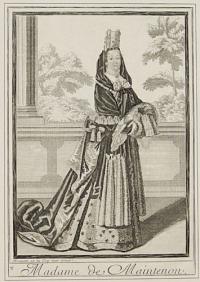
Madame de Maintenon.
HBonnart, ex au Coq, avec privil [c.1700]
Etching, sheet 275 x 190mm (10¾ x 7½"). Trimmed; tipped into album sheet.
Françoise d'Aubigné, Marquise de Maintenon (1635-1719), second wife of Louis XIV. Her marriage to the king was never officially announced or admitted, although she was influential within the court. She founded the Maison royale de Saint-Louis, a school for poor girls from noble families, and used her influence to subsequently secure them prominent positions.
[Ref: 42989] £140.00
(£168.00 incl.VAT)
![[John Maitland, Duke of Lauderdale.]](img-thumbnail/jpegs/43070.jpg)
[John Maitland, Duke of Lauderdale.]
[Painted by John Riley. Engraved by Gerard Valck.]
[n.d., c.1700.]
Engraving. Proof before all letters, 17th century watermark; Sheet: 295 x 245mm (11½ x 8¾"). Trimmed inside plate and tipped into an album sheet.
John Maitland, 1st Duke and 2nd Earl of Lauderdale, 3rd Lord Thirlestane (1616 - 1682), was a Scottish politician, and leader within the Cabal Ministry. By John Riley, portrait painter (1646 - 1691), engraved by Gerard Valck (1651/1652 - 1726), engraver, mezzotinter and publisher, Amsterdam.
[Ref: 43070] £230.00
(£276.00 incl.VAT)
![[Battle of Malaga.]](img-thumbnail/jpegs/42958.jpg)
[Battle of Malaga.] Das See Treffen bey Malaga.
Paulus Decker Archit. invent. et delin. Iohan August Corvinus Sculps.
[Cum Privileg. Sac. Caes. Majest. Ieremias Wolff excudit Aug. Vindelicorum.] [n.d., c.1720.]
Engraving. Sheet: 450 x 400mm (17¾ x 15¾"). Trimmed, part of publication line missing. Couple of rust spots; Central crease.
A scene showing the Battle of Malaga in 1704, the largest naval battle in the War of Spanish Succession. The battle was fought between the United Provinces and England on one side and Bourbon France and Spain on the other. The scene is decorated with a ornate border, with a map of Malaga and its environs below. A plate from 'Repraesentatio belli ob successionem in Regno Hispanico...' published by Wolff.
[Ref: 42958] £380.00
![Reception of Her Royal High. The Princesse of Orange as queene of Great Britain [parallel text in Dutch]](img-thumbnail/jpegs/42379.jpg)
Reception of Her Royal High. The Princesse of Orange as queene of Great Britain [parallel text in Dutch]
R. de Hooge fec.
Tot Leiden By J. Tangena gedruckt met Privilegi [1689]
Etching, sheet 475 x 570mm (18¾ x 22½"). Trimmed inside platemark; repaired vertical and horizontal folds barely visible from front, two cuts from bottom edge to facilitate folding;
A grand image of a new age. The arrival in England of Mary II, daughter of James II who married William of Orange. In 1688 William invaded Britain in the Glorious Revolution, deposing James II and becoming William III, and Mary followed in 1689. Here a large crowd welcomes her while ships in the middle ground and background fire salutes. Various elements are numbered 1-23 although there is no letterpress identification in this state. Etching by Romeyn de Hooghe (1645-1708), exponent of the late Dutch Baroque best known for his political caricatures of Louis XIV and his prints glorifying William III and the Glorious Revolution such as this. De Hooghe's output as an artist was broad, however, and he had other talents and responsibilities: in 1689 he was placed in charge of obtaining building materials for the royal hunting lodge of Het Loo; the same year he became a Doctor of Law at Harderwijk University; he designed ceiling paintings for municipal buildings and church windows; and he wrote several political and historical treatises. See C Mendez & Grosvenor Prints: "Restoration & Revolution 2002" No 28; Landwehr: p153.
[Ref: 42379] £950.00
![[Departure of Marry II from Holland.] Vetrek van haar Koning lyke Hoogheid Mevrouw de Prinses van Oranjen uit Holland den 20 Februar 1689.](img-thumbnail/jpegs/42942.jpg)
[Departure of Marry II from Holland.] Vetrek van haar Koning lyke Hoogheid Mevrouw de Prinses van Oranjen uit Holland den 20 Februar 1689.
Carolus Allard Excudit Cum Privilegie. [n.d., c.1689].
Engraving. Sheet: 295 x 255mm (11½ x 10"). Trimmed and tipped into album sheet.
A scene showing Mary, wife of William of Orange leaving Holland to be crowned Mary II of England.
[Ref: 42942] £320.00
![[Mary II on her deathbed, with William III grieving and courtiers offering condolences]](img-thumbnail/jpegs/42798.jpg)
[Mary II on her deathbed, with William III grieving and courtiers offering condolences]
[Romeyn de Hooghe, 1695]
Etching, sheet 445 x 585mm (17½ x 23"). Trimmed from large broadside, losing text below; three folds.
Mary II on her deathbed. On 24 November 1694 she collapsed with a stroke from which she never recovered, and by Christmas of that year it was clear she was suffering from smallpox. She died at Kensington Palace on the morning of 28 December 1694, and her body was embalmed that day as a precaution against the putrescent effects of smallpox. Top half of a broadside on the death of Mary II in 1694 etched by Romeyn de Hooghe (1645-1708), Dutch Baroque printmaker best known for his political caricatures of Louis XIV and his prints glorifying William III and the Glorious Revolution. Landwehr p.174.
[Ref: 42798] £590.00
![[Title page to series of prints depicting the funeral of Mary II]](img-thumbnail/jpegs/42807.jpg)
[Title page to series of prints depicting the funeral of Mary II] Funeralia Mariae Reginae, Talia Soeva Sonat: per Rostra, Palatia, Templa, Seminecem [...]
Rom: de Hooge I.V.D. et Com: R: Auct.
D. Persoy Excud: Cum Privilegio [c.1691]
Etching, rare; sheet 300 x 185mm (11¾ x 7¼"). Trimmed. Tipped into album sheet.
Mary II (1662-94) privately expressed the wish for a simple funeral, but following her death from smallpox she was given an elaborate burial in Westminster Abbey and the most lavish funeral procession ever held for an English monarch, as depicted in a series of prints by Romeyn de Hooghe to which this is the frontispiece. De Hooghe (1645-1708) was a Dutch Baroque printmaker best known for his political caricatures of Louis XIV and his prints glorifying William III and the Glorious Revolution. Landwehr p.171
[Ref: 42807] £320.00
![[The funeral of Mary II] Lectisternium Ostentiserum. Bed van Parade [...]](img-thumbnail/jpegs/42576.jpg)
[The funeral of Mary II] Lectisternium Ostentiserum. Bed van Parade [...]
[Romeyn de Hooghe]
By Pieter Persoy met Previlegie [1695].
Rare etching with letterpress. heet 325 x 285mm (12¾ x 11¼"). Trimmed; fold through middle as normal.
Mary II's regalia on display after her death in 1694. Plate from Samuel Gruterus, 'Funeralia Mariae II Britanniarum' (Haarlem, 1695), which depicted episodes from the funeral of Mary II (1662-94), queen of England, Scotland and Ireland. Although Mary had privately expressed the wish for a simple funeral, she was buried with elaborate ceremony in Westminster Abbey, and her funeral procession was the largest ever held for an English monarch. Etched by Romeyn de Hooghe (1645-1708), exponent of the late Dutch Baroque best known for his political caricatures of Louis XIV and his prints glorifying William III and the Glorious Revolution. De Hooghe's output as an artist was broad, however, and he had other talents and responsibilities: in 1689 he was placed in charge of obtaining building materials for the royal hunting lodge of Het Loo; the same year he became a Doctor of Law at Harderwijk University; he designed ceiling paintings for municipal buildings and church windows; and he wrote several political and historical treatises. Landwehr Bookplates 87
[Ref: 42576] £420.00
![[Entrance to Whitehall Palace during preparations for the funeral of Mary II]](img-thumbnail/jpegs/42595.jpg)
[Entrance to Whitehall Palace during preparations for the funeral of Mary II] Rou Poort van Withal [...]
[Romeyn de Hooghe]
P Persoy Exc. Cum Previlegie [1695]
Etching with letterpress, sheet 345 x 285mm (13½ x 11¼"). Trimmed; fold through middle as normal.
Plate from Samuel Gruterus, 'Funeralia Mariae II Britanniarum' (Haarlem, 1695), which depicted episodes from the funeral of Mary II (1662-94), queen of England, Scotland and Ireland, showing four sedan chairs in background. Although Mary had privately expressed the wish for a simple funeral, she was buried with elaborate ceremony in Westminster Abbey, and her funeral procession was the largest ever held for an English monarch. Etched by Romeyn de Hooghe (1645-1708), exponent of the late Dutch Baroque best known for his political caricatures of Louis XIV and his prints glorifying William III and the Glorious Revolution. De Hooghe's output as an artist was broad, however, and he had other talents and responsibilities: in 1689 he was placed in charge of obtaining building materials for the royal hunting lodge of Het Loo; the same year he became a Doctor of Law at Harderwijk University; he designed ceiling paintings for municipal buildings and church windows; and he wrote several political and historical treatises.
[Ref: 42595] £380.00
![[Mary II on her deathbed]](img-thumbnail/jpegs/42808.jpg)
[Mary II on her deathbed] Sterven der Koninginne [...]
[Romeyn de Hooghe]
P Persoy Exc. Cum Previlegie [1695]
Etching with letterpress, sheet 285 x 285mm (11¼ x 11¼"). Trimmed; fold through middle as normal.
Mary II attended on her deathbed by William III, Archbishop of Canterbury Thomas Tenison, doctors, and courtiers. Plate from Samuel Gruterus, 'Funeralia Mariae II Britanniarum' (Haarlem, 1695), which depicted episodes from the funeral of Mary II (1662-94), queen of England, Scotland and Ireland. Although Mary had privately expressed the wish for a simple funeral, she was buried with elaborate ceremony in Westminster Abbey, and her funeral procession was the largest ever held for an English monarch. Etched by Romeyn de Hooghe (1645-1708), exponent of the late Dutch Baroque best known for his political caricatures of Louis XIV and his prints glorifying William III and the Glorious Revolution. De Hooghe's output as an artist was broad, however, and he had other talents and responsibilities: in 1689 he was placed in charge of obtaining building materials for the royal hunting lodge of Het Loo; the same year he became a Doctor of Law at Harderwijk University; he designed ceiling paintings for municipal buildings and church windows; and he wrote several political and historical treatises. Landwehr p.172
[Ref: 42808] £280.00
(£336.00 incl.VAT)
![[Burial of Mary II at Westminster Abbey]](img-thumbnail/jpegs/42809.jpg)
[Burial of Mary II at Westminster Abbey] Excell.mo Nob.mo D.o D.o Algernoni Com: d'Essex Vice Com: de Malden. [...]
[Romeyn de Hooghe]
P Persoy Exc. Cum Previlegie [1695]
Etching, sheet 450 x 595mm (17¾ x 23½"). Trimmed, losing text below image; creasing not visible from front.
Plate from Samuel Gruterus, 'Funeralia Mariae II Britanniarum' (Haarlem, 1695), which depicted episodes from the funeral of Mary II (1662-94), queen of England, Scotland and Ireland. Although Mary had privately expressed the wish for a simple funeral, she was buried with elaborate ceremony in Westminster Abbey, and her funeral procession was the largest ever held for an English monarch. Etched by Romeyn de Hooghe (1645-1708), exponent of the late Dutch Baroque best known for his political caricatures of Louis XIV and his prints glorifying William III and the Glorious Revolution. De Hooghe's output as an artist was broad, however, and he had other talents and responsibilities: in 1689 he was placed in charge of obtaining building materials for the royal hunting lodge of Het Loo; the same year he became a Doctor of Law at Harderwijk University; he designed ceiling paintings for municipal buildings and church windows; and he wrote several political and historical treatises. Landwehr p.182
[Ref: 42809] £550.00
![[Funeral Procession of Mary II]](img-thumbnail/jpegs/42810.jpg)
[Funeral Procession of Mary II]
[Romeyn de Hooghe]
P Persoy Exc. Cum Previlegio [1695]
Three etched sheets, rare; each approx 445 x 570mm (17½ x 22½"). Each sheet trimmed in half and pasted one half above the other, with letterpress trimmed and pasted verso; vertical folds to each sheet. Loss on left side 1st plate.
Complete series of views depicting the extraordinary funeral procession for Mary II, which proceeded from the Banqueting House in Whitehall Palace to Westminster Abbey. It remains the largest ever held for an English monarch. Plates from Samuel Gruterus, 'Funeralia Mariae II Britanniarum' (Haarlem, 1695), which depicted episodes from the funeral of Mary II. Etched by Romeyn de Hooghe (1645-1708), exponent of the late Dutch Baroque best known for his political caricatures of Louis XIV and his prints glorifying William III and the Glorious Revolution. De Hooghe's output as an artist was broad, however, and he had other talents and responsibilities: in 1689 he was placed in charge of obtaining building materials for the royal hunting lodge of Het Loo; the same year he became a Doctor of Law at Harderwijk University; he designed ceiling paintings for municipal buildings and church windows; and he wrote several political and historical treatises. Landwehr pp.176-181. Numbered 1-78. See C Mendez & Grosvenor Prints "Restoration & Revolution 2002" No 35.
[Ref: 42810] £950.00
view all images for this item
![[Marie de Medici surrounded by her children]](img-thumbnail/jpegs/43012.jpg)
[Marie de Medici surrounded by her children]
[Lucas Vorsterman after Nicolaas van der Horst]
[Published by Balthasar Moretus, 1632]
Engraving, sheet 235 x 165mm (9¼ x 6½"). Laid onto album sheet on left margin.
Marie de Médicis, Queen and Regent of France (1573-1642), wife of King Henry IV of France, of the Bourbon branch of the kings of France. Later she was the regent for her son King Louis XIII of France. Shown here framed within a tree, from the branches of which grow her children: Louis XIII of France; Henrietta Maria; Elisabeth, Gaston of Orléans; and Christine Marie of Savoy. Fame and Fortune water the tree in lower corners. Illustration to Jean Puget de la Serre's 'Histoire Curieuse de tout ce qui c'est passé a l'Entree de la Reyne Mere du Roy Treschrestien dans les Villes des Pays Bas" (Antwerp: Moretus, 1632)
[Ref: 43012] £180.00
(£216.00 incl.VAT)
![[Raid on the Medway.] Disegno dell'Ingresso, et Abbrvecia, Mento di Vascelli Inglesi Fattoda'gli Olandesi nella Riviera di Hattan.](img-thumbnail/jpegs/42717.jpg)
[Raid on the Medway.] Disegno dell'Ingresso, et Abbrvecia, Mento di Vascelli Inglesi Fattoda'gli Olandesi nella Riviera di Hattan.
A. Blom. del. et. f.
[n.d., c.1667.]
Rare etching. Plate: 380 x 300mm (15 x 12"), with very large margins. Three vertical folds, damage to edge of plate in lower left edge.
A scene showing the burning of the English fleet following the Dutch raid on the Medway in June 1667 during the Second Anglo-Dutch War. From Galeazzo Gualdo Priorato's ''Teatro del Belgio o sia descritione delle diecisette Provincie del medesimo''.
[Ref: 42717] £280.00
(£336.00 incl.VAT)
![[Raid on the Medway.] Afbeelding van de Stad en Revier van Rochester, Chattam...](img-thumbnail/jpegs/42935.jpg)
[Raid on the Medway.] Afbeelding van de Stad en Revier van Rochester, Chattam...
Stoopendal sculp.
[n.d., c.1667.]
Engraving, with letterpress. Sheet: 260 x 340mm (10¼ x 13½"). Trimmed to image, tipped into album sheet, vertical central fold as normal. Letterpress trimmed and laid on album sheet below. Foxing & creasing.
A scene showing the Raid on the Medway by the Dutch led by Admiral de Ruyter in 1667 during the Second Anglo-Dutch War. Letterpress description in French below, with key identifying key locations and ships.
[Ref: 42935] £320.00
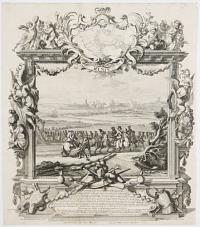
Menin.
Georg Phil. Rugendas del. Abraham Drentwett Ornam: del. Ioh: August: Corvinus Sculpsit.
Cum Gratia et Privileg: Sac: Caes: Maj. Ieremias Wolff excudit Aug. Vind. [n.d., c.1720.]
Engraving. Sheet: 375 x 430mm (14¾ x17"). Trimmed to image. Foxing. Creasing hardly visible from front.
A battle scene, showing the Duke of Marlborough's Allied army capturing the town of Menin in Flanders in August 1706. The scene is framed with a decorative border. A plate from 'Repraesentatio belli ob successionem in Regno Hispanico...' published by Wolff.
[Ref: 42532] £270.00
(£324.00 incl.VAT)
![[George Monck.]](img-thumbnail/jpegs/43057.jpg)
[George Monck.]
[n.d., c.1660.]
A very rare engraving. Sheet: 180 x 140mm (7 x 5½"). Trimmed and laid into an album sheet.
A full length portrait of George Monck, 1st Duke of Albemarle (1608-1670), a soldier and politician who was an important figure in the Restoration of Charles II in 1660, shown standing in a landscape resting on a stick.
[Ref: 43057] £260.00
(£312.00 incl.VAT)

James Duke of Monmouth. Mortuus 15 July 1685. Ætat 36. The Gods from Heaven survey the fatal Strife And mourn the Miseries of human Life.
From a Painting by Netcher and Wyke, in the Collection of W.m Baillie Esq.r. W.Baillie fec. 30 Sept. 1774.
Mezzotint with text printed from separate plate, sheet 400 x 410mm (15¾ x 16"). Trimmed; two vertical folds.
James Scott, duke of Monmouth and the first duke of Buccleuch (1649-1685), politician and illegitimate son of Charles II, on horseback, with the Battle of Sedgemoor (6 July 1785) in the background. The Battle of Sedgemoor, fought near Bridgwater in Somerset, was the last act of the Monmouth Rebellion (in which Monmouth attempted unsuccessfully to depose his uncle, King James II). Monmouth's men were routed, and although Monmouth himself escaped, he was found hiding in a ditch two days later. He was taken back to London, imprisoned in the Tower, and executed a few days later. Monmouth was allowed to be beheaded rather than the usual method of hanging, but the executioner took five strokes of the axe to sever the head; after the first stroke Monmouth was said to have raised his head in anguish. CS 4; for other impressions see refs. 4393-4.
[Ref: 42791] £360.00
![[James Scott, Duke of Monmouth greeting his supporters.]](img-thumbnail/jpegs/42794.jpg)
[James Scott, Duke of Monmouth greeting his supporters.]
Engraving, sheet 165 x 220mm (6½ x 8½"). Glued to album sheet at edges.
A naive engraving of a scene showing James Scott, Duke of Monmouth greeting his followers, the faces are copies of well-known portraits Monmouth's is a copy of Blooteling's mezzotint after Peter Lely.
[Ref: 42794] £260.00
(£312.00 incl.VAT)
![[Execution of James Scott, duke of Monmouth]](img-thumbnail/jpegs/42547.jpg)
[Execution of James Scott, duke of Monmouth] Der Brittannische --stadt
[Anon. German, c.1690]
Rare engraving, sheet 190 x 305mm (7½ x 12"). Trimmed, losing text key to numbers in image, and glued to backing sheet.
Figure being beheaded on a scaffold with large crowd in attendance; oval portraits of James Scott, first duke of Monmouth and Buccleuch (1649 -1685), illegitimate son of Charles II, and his confederate Archibald Campbell, ninth Earl of Argyll (1629 - 1685), politician and clan leader. The scene shows the execution of Monmouth, who was beheaded rather than hanged (the more common form of execution) at the king's agreement. Even though Monmouth paid his executioner well, however, he did his job poorly and took five strokes to sever Monmouth's head from his body. After the first stroke Monmouth was reportedly seen to raise his head in anguish.
[Ref: 42547] £450.00
![[The Capture of Mons.]](img-thumbnail/jpegs/42528.jpg)
[The Capture of Mons.] Die Eroberung Mons.
P. Decker junior del. P. Decker Archit inv. et del. Iohann August: Corvinus Sculpsit.
[Cum Gratia et Privileg: Sac: Caes: Maj. Ieremias Wolff excudit Aug. Vind.] [n.d., c.1720.]
Engraving. Sheet: 370 x 450mm (14¼ x 17¾"). Trimmed inside image. Repaired tear at centre bottom.
A battle scene showing the attempted capture of Mons by the Duke of Marlborough in September 1709, the French and Allied armies eventually met each other in the gap of Malplaquet south of Mons, following the Allies' victory at the Battle of Malplaquet they returned their attention to Mons, now defended by a weaker French force, and were eventually able to capture her. The central scene shows soldiers resting in the camp, a group play cards, while in the background Mons is shown under fire. Framed by a highly decorative border, a small map of Mons is shown above. A plate from 'Repraesentatio belli ob successionem in Regno Hispanico...' published by Wolff.
[Ref: 42528] £220.00
(£264.00 incl.VAT)
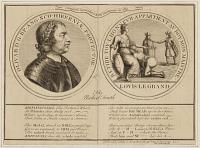
The Naked Truth. Britannia's Isle, like Fortune's Wheel, In Politicks does daily reel...
Published according to Act of Parl.t the 23es day of June 1739. f.i.c. by John Brett.
Engraving. Sheet: 265 x 195mm (10½ x 7¾"). Trimmed, folds and laid on album sheet. Damaged.
A satirical broadside which comments on Robert Walpole's reluctance to go to war in the 1730s. It is a print of a medal struck during the rule of Oliver Cromwell which commented on France and Spain's subservience to him, however in this print Cardinal Fleury of France replaces Cromwell and the Dutch ambassador and Walpole replace the Spanish and the French ambassadors. Fleurey, resting his head in the lap of Britannia presents his bare behind while Walpole and the Dutch Ambassador debate who has to kiss it first. BM Satire 2147.
[Ref: 42690] £280.00
(£336.00 incl.VAT)
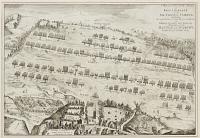
A Representation of the Armies of King Charles I and Sir Thomas Fairfax, exhibiting the exact Order in which the Several Bodies of Infantry and Cavalry were drawn up, Preparatory to the Battle of Naseby, fought the 14th of June 1645.
[n.d., c.1700.]
Engraving. Sheet: 260 x 375mm (10¼ x 14¾"). Trimmed and tipped into album sheet.
A topographical battle plan showing the armies of Charles I and Prince Rupert and Oliver Cromwell and Thomas Fairfax at the Battle of Naseby in 1645, with a portrait of Fairfax in an oval in the top right corner. The Battle of Naseby was a decisive battle in the First Civil War as it all but destroyed the Royalist force and within a year Parliament had won the war. A later copy of a larger print by John Streater.
[Ref: 42938] £280.00
(£336.00 incl.VAT)
![James Naylor [Nayler].](img-thumbnail/jpegs/42123.jpg)
James Naylor [Nayler]. Born at Adresloe near Wakefeild in Yorkshire, Was an Independent & Served Quarter Master in ye Parliament Army about ye Year 1641, Turn'd Quaker in 1651, Published as a Blasphemer 1656, Author of many Books & Dyed at Holm in Huntingtonshire 1660, Aged 44.
T. Preston Fecit [after Francis Place].
[n.d., c.1750.]
Rare mezzotint. 235 x 160mm (9¼ x 6¼"). Thread margins.
Having been a quarter-master in the Parliamentarian army, Nayler became a Quaker in 1651, joining the Valiant Sixty, a group of early Quaker preachers and missionaries. Nayler [1618-60] was one of the more radical members, and in 1656 he and his friends staged a demonstration entering Bristol on a donkey, re-enacting Christ's entering Jerusalem. Nayler was arrested and convicted of blasphemy; branded on the forehead with the letter B and his tongue bored through, he went to prison for two years. On his release he repented of his actions, but continued his Quaker life until he died a day after being mugged. Despite the blasphemy he remained an influential figure to the Quaker movement.
[Ref: 42123] £260.00
(£312.00 incl.VAT)
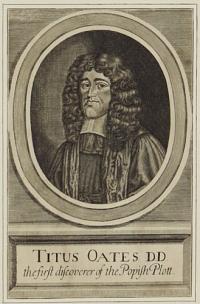
Titus Oates D.D. the first discoverer of the Plott.
[?David Loggan]
[n.d. c.1680.]
Engraving, sheet 225 x 140mm (8¾ x 5½"). Trimmed and glued to backing sheet at edges.
Titus Oates (1649-1705), perjurer who fabricated the 'Popish Plot', a supposed Catholic conspiracy to kill King Charles II and incite an insurrection. He began his career as an Anglican priest, but converted to Catholicism in 1677. This secured his admission to Jesuit college at St Omer, and this gave plausibility to his story about a Catholic plot. Oates swore his testimony to Sir Edmund Berry Godfrey in September 1678, and it was Godfrey's murder a few weeks later (a death that has never been explained) that overnight turned the plot in the public mind from allegation to certainty. Oates managed to retain a central role in the unfolding affair by continually inventing new accusations. In 1684, in the flood of the Tory reaction, he was prosecuted for perjury, and in 1685 sentenced to the pillory and public flogging. The Glorious Revolution saved him; he was pardoned, given a pension and married a wealthy widow. For similar image in reverse see ref. 25272.
[Ref: 42609] £190.00
(£228.00 incl.VAT)
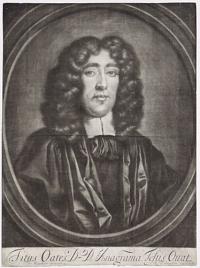
Titus Oates. D.D. Anagrama Tetis Ouat.
Tho: Hauker pinxit. R. Tompson excudit.
[n.d., c.1680.]
Mezzotint. Sheet: 345 x 255mm (13½ x 10"). Trimmed within plate, creased.
A portrait of Titus Oates in an oval. Titus Oates (1649-1705) was an English perjurer who fabricated the 'Popish Plot', a supposed Catholic conspiracy to kill King Charles II. He began his career as an Anglican priest, but converted to Catholicism in 1677. This secured his admission to Jesuit college at St Omer, and this gave him enough information to give his story about a Catholic plot to murder Charles some plausibility. Oates swore his testimony to Sir Edmund Berry Godfrey in September 1678, and it was Godfrey's murder a few weeks later (a death that has never been explained) that overnight turned the plot in the public mind from allegation to certainty. Oates managed to retain a central role in the unfolding affair by continually inventing new accusations. In 1684, in the flood of the Tory reaction, he was prosecuted for perjury, and in 1685 sentenced to the pillory and public flogging. The Glorious Revolution saved him; he was pardoned, given a pension and married a wealthy widow. CS: 32
[Ref: 43041] £230.00
(£276.00 incl.VAT)
![[Siege of Ostend.]](img-thumbnail/jpegs/42953.jpg)
[Siege of Ostend.] Die Wunder Glükliche Eroberung der Haupt Vestung Ostende.
Paulus Decker Archit. invent: et delin. Martinus Engelbrecht Sculpsit.
[Cum Gratia et Priv: Sac: Caes: Maj. Ieremias Wolff excudit Aug. Vind.] [n.d., c.1720.]
Engraving. Sheet: 450 x 360mm (17¾ x 14"). Trimmed, part of publication line missing. Vertical crease, not visible from front.
A scene showing the Spanish attack on Ostend in 1604 following a three year long siege during the Eighty Years War, the Spanish eventually took the city and it was destroyed. The scene is framed in a decorative border. A plate from 'Repraesentatio belli ob successionem in Regno Hispanico...' published by Wolff.
[Ref: 42953] £320.00
![[Battle of Oudenarde.]](img-thumbnail/jpegs/42527.jpg)
[Battle of Oudenarde.] Sieg beÿ Oudenarde A.o 1708.
S.P. Rugendas del. Abraham Drentwett Ornamet: del. Ioh: August: Corvinus Sculpsit.
Cum Gratia et Privileg: Sac: Caes: Maj. Ieremias Wolff excudit Aug. Vind. [n.d., c.1720.]
Engraving. Sheet: 390 x 425mm (15¼ x 16¾"). Trimmed to image. Some light staining. Creasing hardly visible from front.
A battle scene showing the Battle of Oudenarde which took place on 11th July 1708 between Great Britain, the Dutch Republic, the Holy Roman Empire who were allied against the French during the War of Spanish Succession. The scene in framed in a highly decorative border with a battle plan depicted at the top. A plate from 'Repraesentatio belli ob successionem in Regno Hispanico...' published by Wolff.
[Ref: 42527] £280.00
(£336.00 incl.VAT)
![[Parliament in session at Westminster Hall, 1689]](img-thumbnail/jpegs/42597.jpg)
[Parliament in session at Westminster Hall, 1689] Afbeeldinge van de Raadsvergaderinge der Geestelyke en Wereltlyke Heeren Tot Westmunster, aangevangen op den 1 February 1689
[Cornelis Huyberts; published by Jacobus Robyn, 1689]
Etching, scarce; sheet 290 x 485mm (11½ x 19"). Trimmed, losing letterpress text below image; creases; 'The Marquis of Halifax Speaking in Parliament' in old mss.
Thirteen sitters are identified by a numbered key, including William III and George Saville, first marquis of Halifax, although the letterpress identifying the sitters has been trimmed away from the print. See BM 1859,0709.1572
[Ref: 42597] £650.00
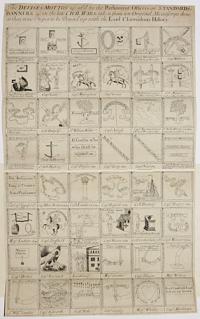
The Devises Motto's &c used by the Parliament Officers on Standards, Banners, &c. in the late Civil Wars; taken from an Original Manuscript done at that time: Proper to be bound up with the Lord Clarendon's History.
[after Benjamin Cole.]
[n.d., c.1720.]
Engraving, bisected horizontally. Sheets 345 x 400mm (13½ x 15¾") & 300 x 400mm (11¾ x 15¾"). Trimmed within plate, top sheet mounted on album paper.
A sheet of 48 illustrations of Parliamentarian banners, each with a caption, published in an edition of Edward Hyde, 1st Earl of Clarendon's 'The History of the Rebellion and Civil Wars in England', first published 1704. A version in the British Library, engraved by James Cole with the same images but a different title, has an engraved text at the bottom. Both were copied from a broadside by Benjamin Cole (see item 42951). See BM: 1917,1208.2338 for James Cole's variant.
[Ref: 42950] £950.00
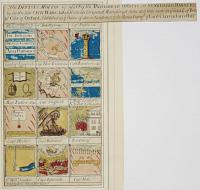
The Devises Motto's &c used by the Parliament Officers on Standards, Banners, &c. in the late Civil Wars; taken from an Original Manuscript done at that time, now in ye hands of Benja.n Cole of Oxford: Published at ye Desire of divers Gentleman to be Bound upw.h ye Lord Clarendon's Hist.ry. Price 5.sh
Sold by Benj. Cole in Bear Lane [n.d., c.1710.]
Engraved broadside with contemporary hand colour. Dissected into four sheets, each 325 x 195mm (12¾ x 7¾"), plus original title 35 x 390mm (1¼ x 15¼") Trimmed, laid on album paper, title folded in half and pasted above top left section.
A very scarce sheet of 48 illustrations of Parliamentarian banners, each with a caption. Although the title states the sheet was to be issued in an edition of Edward Hyde, 1st Earl of Clarendon's 'The History of the Rebellion and Civil Wars in England' (first published 1704), the colour suggests this example was a separate issue. The printed area is complete, but the four sections have been pasted in the wrong order, with the caption to Captain Trenchard's banner in the wrong place. The British Museum example has similar (but not identical) colour, is bisected horizontally and has Cole's publication line damaged. BM: 1852,0214.554-555.
[Ref: 42951] £1,500.00
view all images for this item
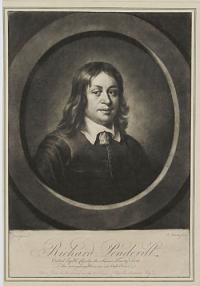
Richard Penderill. Called by K. Charles the Second Trusty Dick For concealing Him in an Oak Tree
Zoust pinxt. R. Houston fecit.
Done from the Original in the Collection of Charles Jennens Esqr.
Mezzotint, sheet 325 x 220mm (12¾ x 8½"). Trimmed; tipped into album sheet.
Richard Penderel (d.1672) was a yeoman and royalist sympathiser, born in Shropshire, who assisted in Charles II's escape after the battle of Worcester and was thus rewarded by the king after the Restoration. Engraved after a portrait by Gilbert Soest (1600-?1681), Dutch portrait painter and rival to Sir Peter Lely in London CS: 88: ii.
[Ref: 43044] £220.00
(£264.00 incl.VAT)
![The North-East Prospect of Plymouth, in the County of Devon. [&] The West Prospect of His Majesties Dock-Yard, Near Plymouth.](img-thumbnail/jpegs/43058.jpg)
The North-East Prospect of Plymouth, in the County of Devon. [&] The West Prospect of His Majesties Dock-Yard, Near Plymouth.
Sam.l and Nath.l Buck delin. et Sculp.t.
according to Act of Parliament 1736.
A pair of engravings. Plates: 310 x 790mm (12¼ x 31"). Central folds as normal.
A pair of detailed views of Plymouth, with a descriptive text below and a key to the right, indicating various landmarks and buildings. From the series 'Buck's Perspective Views of Cities and Chief Towns in England and Wales', before the addition of a plate number top right.
[Ref: 43058] £700.00
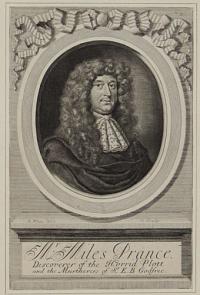
Mr: Miles Prance. Discoverer of the Horrid Plott and the Murtherers of Sr. E.B. Godfree.
R. White delin: et Sculp:
[n.d. c.1679.]
Engraving, sheet 235 x 150mm (9¼ x 6"). Trimmed; laid into album sheet at edges.
Miles Prance (fl.1678-88), perjurer involved in the 'Popish Plot', a supposed Catholic conspiracy to kill Charles II. Prance was arrested in relation to the death of Sir Edmund Berry Godfrey (to whom Titus Oates had sworn testimony), and after admitting involvement in Godfrey's murder (which has never been conclusively proved), gave evidence against Henry Berry, Robert Green, and Lawrence Hill, who were executed as a result. Prance, meanwhile shared with William Bedloe the reward for the discovery of the murderers. Under the influence of Bedloe and Oates, Prance subsequently informed on a number of Catholics and published pamphlets defending his evidence. Prance faded from view with the ebbing of the Popish Plot, but in 1686 he was found guilty of perjury, fined and stood in the pillory at Westminster (although he was spared the whipping he was sentenced to). Frontispiece to Prance's 'True Narrative and Discovery of several very remarkable passages relating to the horrid Popish Plot' (1679).
[Ref: 42792] £190.00
(£228.00 incl.VAT)
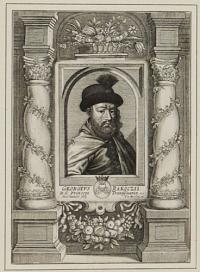
Georgius Rakoczii D.G. Princeps Transylvaniae etc.
Fred Bouttats sculp.
T. v. Merlen ex [c.1660]
Engraving, sheet 160 x 110mm (6¼ x 4¼"). Trimmed; glued to backing sheet at edges.
György Rákóczi II (1621-1660), prince of Transylvania. After making alliances with Sweden amongst other countries Rákóczi led a war against Poland which, after initial advances, ended badly. His land was subsequently invaded by Ottoman Turks and he died in battle in 1660.
[Ref: 42988] £120.00
(£144.00 incl.VAT)

![[Plan of Westminster Abbey as arranged for coronation of James II]](img-thumbnail/jpegs/42918.jpg)
![[James II in his palace with parliament entering; revoking his decision to form a parliament; arriving in Ambleteuse by boat; and arriving in St Germain-en-Laye]](img-thumbnail/jpegs/42559.jpg)
![[James II intercepted at Faversham; embarking at Rochester; arriving in Ambleteuse; and riding from Boulogne to Paris]](img-thumbnail/jpegs/42565.jpg)
![[James II] The Flight of the Popedom out of England.](img-thumbnail/jpegs/42697.jpg)
![[James II lands at Kinsale in Ireland]](img-thumbnail/jpegs/42591.jpg)






![[The Seminary of Lingen]](img-thumbnail/jpegs/42797.jpg)
![[Battle of Lowestoft.] Battaglia Navale tra'Inglesi, et Olandesi Successa adi 13 di Gingno 1665.](img-thumbnail/jpegs/42718.jpg)


![[John Maitland, Duke of Lauderdale.]](img-thumbnail/jpegs/43070.jpg)
![[Battle of Malaga.]](img-thumbnail/jpegs/42958.jpg)
![Reception of Her Royal High. The Princesse of Orange as queene of Great Britain [parallel text in Dutch]](img-thumbnail/jpegs/42379.jpg)
![[Departure of Marry II from Holland.] Vetrek van haar Koning lyke Hoogheid Mevrouw de Prinses van Oranjen uit Holland den 20 Februar 1689.](img-thumbnail/jpegs/42942.jpg)
![[Mary II on her deathbed, with William III grieving and courtiers offering condolences]](img-thumbnail/jpegs/42798.jpg)
![[Title page to series of prints depicting the funeral of Mary II]](img-thumbnail/jpegs/42807.jpg)
![[The funeral of Mary II] Lectisternium Ostentiserum. Bed van Parade [...]](img-thumbnail/jpegs/42576.jpg)
![[Entrance to Whitehall Palace during preparations for the funeral of Mary II]](img-thumbnail/jpegs/42595.jpg)
![[Mary II on her deathbed]](img-thumbnail/jpegs/42808.jpg)
![[Burial of Mary II at Westminster Abbey]](img-thumbnail/jpegs/42809.jpg)
![[Funeral Procession of Mary II]](img-thumbnail/jpegs/42810.jpg)
![[Marie de Medici surrounded by her children]](img-thumbnail/jpegs/43012.jpg)
![[Raid on the Medway.] Disegno dell'Ingresso, et Abbrvecia, Mento di Vascelli Inglesi Fattoda'gli Olandesi nella Riviera di Hattan.](img-thumbnail/jpegs/42717.jpg)
![[Raid on the Medway.] Afbeelding van de Stad en Revier van Rochester, Chattam...](img-thumbnail/jpegs/42935.jpg)

![[George Monck.]](img-thumbnail/jpegs/43057.jpg)

![[James Scott, Duke of Monmouth greeting his supporters.]](img-thumbnail/jpegs/42794.jpg)
![[Execution of James Scott, duke of Monmouth]](img-thumbnail/jpegs/42547.jpg)
![[The Capture of Mons.]](img-thumbnail/jpegs/42528.jpg)


![James Naylor [Nayler].](img-thumbnail/jpegs/42123.jpg)


![[Siege of Ostend.]](img-thumbnail/jpegs/42953.jpg)
![[Battle of Oudenarde.]](img-thumbnail/jpegs/42527.jpg)
![[Parliament in session at Westminster Hall, 1689]](img-thumbnail/jpegs/42597.jpg)



![The North-East Prospect of Plymouth, in the County of Devon. [&] The West Prospect of His Majesties Dock-Yard, Near Plymouth.](img-thumbnail/jpegs/43058.jpg)

